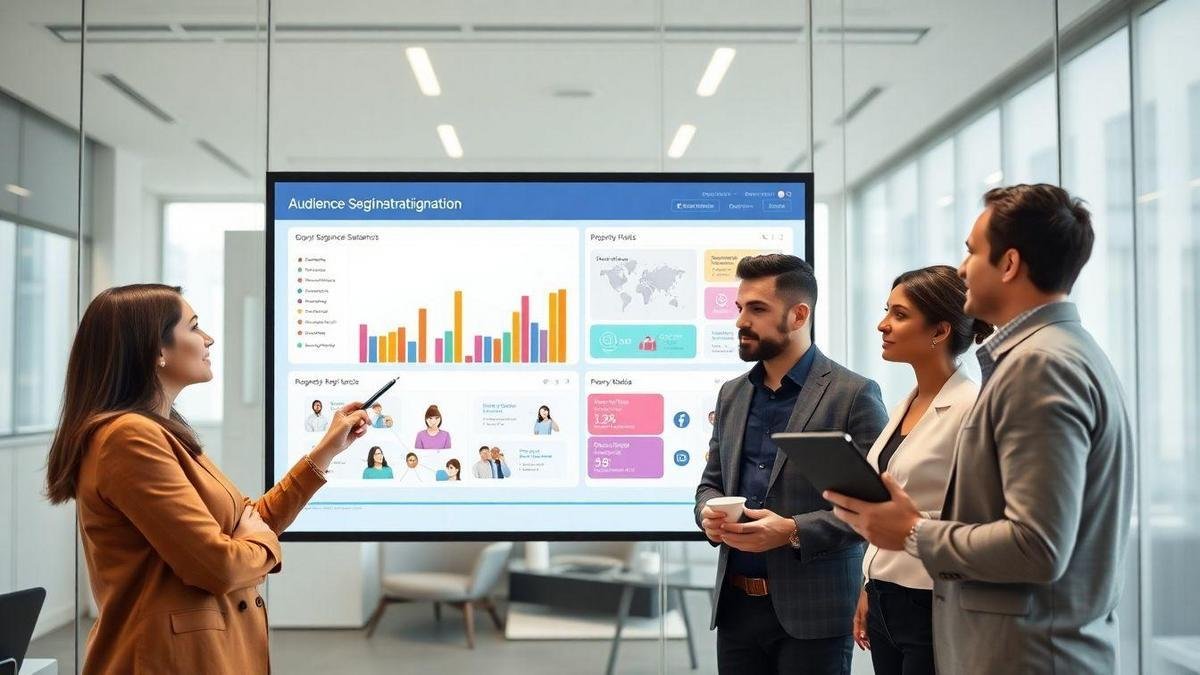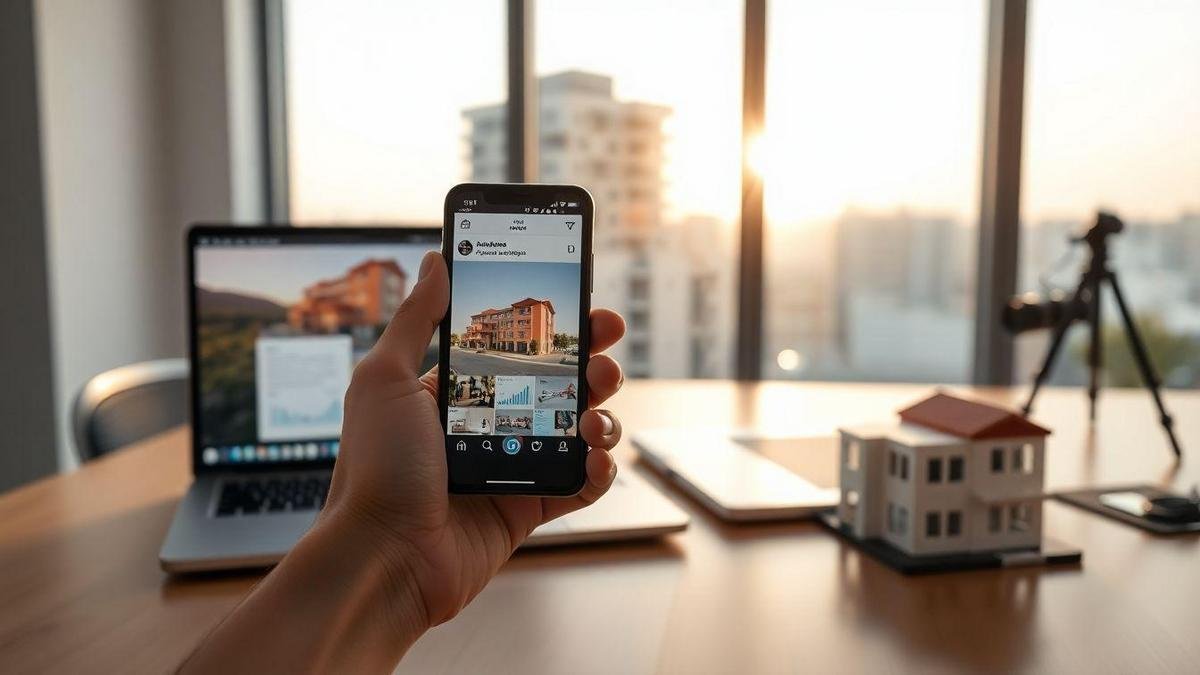Social media marketing for real estate developers gives the developer a clear, tactical roadmap. It shows how to set campaign goals, track key metrics, and align channels, content, and sales teams. It maps audience segmentation and buyer personas, and lays out best practices for Instagram, Facebook ads, and LinkedIn to capture leads. It also covers visual content, virtual tours, influencers, and community to turn followers into referrals.
- Target local buyers with clear audience profiles.
- Use high-quality photos and short videos to show properties.
- Post on a regular schedule to stay top of mind.
- Use targeted ads and simple lead forms to capture interest.
- Reply quickly to messages and share client testimonials.

Strategic framework for Social media marketing for real estate developers
How developers set clear campaign goals
Developers start with a single, measurable goal. Keep goals short and concrete. Examples: sell 20 units in 90 days, capture 300 qualified leads, or boost site visits by 40%. For practical campaign structures and channel planning, pair goal-setting with a tested digital marketing strategy for real estate.
Next, define the target audience: age, income, location, and buying stage. Clear audience definition cuts wasted spend. Set a timeline and budget: small tests run for 2–4 weeks; bigger pushes run 6–12 weeks. Test with small budgets to learn fast, then scale winners.
Goals follow simple rules:
- Be specific (what and how many).
- Be measurable (numbers and dates).
- Be time-bound (a clear end date).
Real example: a coastal developer ran a 6-week campaign to sell 10 beach condos, targeted buyers within a 100-mile radius, used short video tours, and tracked leads daily. They hit 80% of the sales goal by week 5 because the goal and audience were focused.
Key metrics for real estate developer social media strategy
Track metrics that link to sales. Focus on the numbers that move the needle.
| Metric | What it shows | Simple benchmark |
|---|---|---|
| Impressions | How many times content appears | High is good; watch frequency |
| Reach | How many people saw the content | Grow month over month |
| Engagement rate | Likes, comments, shares per view | 0.5%–3% for property posts |
| CTR (click-through rate) | Clicks to landing page per impression | 0.5%–2% |
| Leads | Contact forms or calls | Track weekly |
| CPL (cost per lead) | Ad spend ÷ leads | Varies by market; compare to price per unit |
| Conversion rate | Leads that become visits or deposits | 2%–10% depending on funnel |
| Time to close | Days from lead to sale | Track to forecast cash flow |
| ROAS | Return on ad spend | Positive return within campaign life |
If engagement is high but CTR is low, creative likely needs improvement. If CPL is low but conversions are low, check lead quality.
Aligning channels, content, and sales teams
Map each channel to a role in the funnel—like a relay race: each team passes the lead smoothly to the next.
| Channel | Primary role | Content type | Sales handoff |
|---|---|---|---|
| Awareness & inspiration | Short videos, photos, reels | Lead form → CRM tag “Insta” | |
| Lead capture & events | Ads, live tours, events | Book showing → Sales alert | |
| Investor & commercial leads | Project updates, whitepapers | Intro email → Account rep | |
| YouTube | Long-form tours & proof | Property tours, testimonials | CTA to landing → Nurture flow |
| Nurture & conversions | Drip sequences, offers | Appointment link → Sales follow-up |
Handoff checklist for each lead:
- Tag source and campaign in the CRM.
- Send automated confirmation within 15 minutes.
- Assign lead to a sales rep within 1 business day.
- Track next action and update status.
Run weekly alignment calls: marketing shares top creatives; sales reports lead quality and closes. Small fixes—change a landing page field or tweak ad copy—can lift results quickly.

Targeted audience segmentation for property marketing in Social media marketing for real estate developers
Identifying buyer personas for development projects
Start with clear buyer personas—short profiles showing needs, budget, timelines, and decision drivers. Common personas:
- First‑time buyer — 25–35, prioritizes affordability and commute.
- Young professional — single, seeks amenities and social spaces.
- Family upsizer — needs schools, safety, outdoor space.
- Empty nester/downsizer — prefers low maintenance and convenience.
- Investor — focuses on yield, resale, rental demand.
- Luxury buyer — buys on lifestyle, privacy, prestige.
Practical steps:
- Collect sales team feedback and viewing notes.
- Use simple surveys at open houses to capture priorities.
- Review CRM records for purchase speed and objections.
- Watch what content each persona engages with on social channels.
These profiles guide message, tone, and offer—match creative to each persona’s main motivator and barrier.
Using demographics and behavior data for targeting
Use demographics to define who they are and behavioral signals to understand what they do online.
Key demographics:
- Age, income, household size, location, occupation.
Key behavior signals:
- Page visits to floor plans or pricing.
- Video plays of property tours.
- Ad clicks and lead form submissions.
- Time spent on amenity or neighborhood pages.
- Interaction with chat or messaging tools.
| Signal observed | Actionable targeting | Example metric |
|---|---|---|
| Visits floor plans repeatedly | Retarget with unit availability | 3 page views |
| Watches full video tour | Send scheduling link for showings | Video completion |
| Searches neighborhood info | Serve local amenity posts | Search keywords |
| Clicks finance calculator | Offer mortgage content or contact | Click rate |
Use these signals for retargeting, lookalike audiences, and message sequencing. Run short tests to learn which combos perform best.
Mapping channels to audience segments
Match channels to persona habits.
| Segment | Best channels | Content type |
|---|---|---|
| First‑time buyer | Facebook, Instagram Stories, WhatsApp | Short tips, financing help, FAQs |
| Young professional | Instagram, TikTok, YouTube Shorts | Lifestyle videos, amenity highlights |
| Family upsizer | Facebook, YouTube, email | School guides, floor plans, neighborhood tours |
| Empty nester | Facebook, LinkedIn, email | Comfort, maintenance benefits, virtual tours |
| Investor | LinkedIn, YouTube, email newsletters | Market data, yield calculators, case studies |
| Luxury buyer | Instagram, YouTube, private messaging | High‑quality video, virtual walkthroughs, exclusive invites |
Channel notes:
- Use video on most channels for higher engagement.
- Use messaging apps for direct follow-up after a lead.
- Match ad format to attention span: short clips for feeds; longer tours on YouTube.
- Schedule posts when each persona is most active.
Treat this mapping as a living chart and tweak after testing—small changes can improve lead quality fast.

Instagram marketing for property developers: visual storytelling and lead capture
Social media marketing for real estate developers must move beyond basic posts. Use visual storytelling that captures attention and turns viewers into leads. A strong Instagram plan pairs striking visuals with simple pathways to contact. Treat each post like a guide: show the view, the flow, and how to book a visit. Every post has a clear goal: engage, educate, or capture leads.
Best post types for showcasing developments
Choose formats that match the message.
- Photo carousels show layout, finishes, and views in a single swipe.
- Drone shots display scale and context; use professional drone and aerial photography techniques where appropriate.
- Walkthrough clips make space feel alive.
- Before/after posts highlight progress and credibility.
- Resident testimonials build trust fast.
- Floorplan images with hotspots help buyers imagine life in the space.
- User-generated content brings third-party proof.
| Post type | Primary goal | Example CTA |
|---|---|---|
| Photo carousel | Show features | Book a tour |
| Drone image | Show site context | View site map |
| Walkthrough video | Evoke presence | Schedule visit |
| Testimonial | Build trust | Contact agent |
| Before/after | Show progress | Join waitlist |
Treat each post as a step in a short journey: hook (visual), brief caption, bold and clear CTA.
Using Reels and Stories to boost engagement and visits
- Reels expand reach fast—motion and emotion perform well (15–30s walkthroughs, architect interviews, time-lapse builds).
- Stories are the daily pulse—use stickers (polls, countdowns, contact) to drive quick action.
- Use Reels for discovery and Stories for conversion.
| Feature | Best use | Quick tip |
|---|---|---|
| Reels | Reach new audiences | Start with the best shot in the first 3s |
| Stories | Push fast actions | Add a clear link or contact sticker |
| Highlights | Keep key info visible | Save floorplans, tours, and FAQs |
Example: post a 20-second Reel of a sunrise balcony view, follow with a Story linking to the booking form—often turns passive scrolls into booked visits. Post Reels 1–3 times weekly and update Stories daily during open houses or launches.
Creating an Instagram content calendar
A content calendar keeps posts consistent and purposeful.
Steps:
- Map weekly themes: product, process, people, place.
- Assign formats: Reel, carousel, Story, testimonial.
- Reserve slots for real-time updates: site progress, events.
- Track leads from each post in one sheet.
Sample weekly calendar
| Day | Format | Theme | Goal |
|---|---|---|---|
| Monday | Carousel | Floorplans & finishes | Educate |
| Wednesday | Reel | Walkthrough or view | Discover |
| Friday | Testimonial post | Resident or broker praise | Trust |
| Daily | Stories | Progress / Q&A | Convert |
Keep captions short with a simple script: Hook > Benefit > CTA. For example: “See the river view. Imagine mornings here. Book a tour.”

Facebook ads for real estate developers: targeted lead capture and retargeting
Facebook ads help pull high-quality leads fast. Mix cold outreach with warm follow-up. Use clear offers, tight audiences, and staged messaging to move prospects from curious to contact. This is a core element of Social media marketing for real estate developers—put listings in front of the right people at the right moment. A simple, short funnel often beats a long, complex one.
Choosing ad objectives and audience layers
Pick objectives that match buyer stage: for new prospects, run video views or traffic; for ready leads, choose lead generation or conversions. Build audiences in layers: cold, warm, hot—each with tailored creative and CTA.
| Audience Layer | Goal | Creative | Targeting Signals | Key Metric |
|---|---|---|---|---|
| Cold | Awareness | Short video or carousel | Demographics, interest, lookalike | CTR |
| Warm | Consideration | Testimonial, virtual tour | Engaged users, video viewers | Engagement rate |
| Hot | Conversion | Lead form, offer | Website visitors, leads list | CPL |
Monitor metrics daily. If CTR drops, refresh creative. If CPL rises, tighten targeting. Small changes shift results quickly.
Crafting ad creative and effective landing pages
Match creative to audience:
- Cold traffic: short tour or lifestyle image.
- Warm traffic: floor plan or pricing table.
- Hot traffic: simple form with a clear incentive.
| Ad Type | Best Use | Landing Page Need |
|---|---|---|
| Video (15–30s) | Brand / project vibe | Fast load, autoplay muted clip |
| Carousel | Multiple units or amenities | Gallery quick lead form |
| Image | Simple offer | Clean headline CTA button |
| Instant Experience | Immersive preview | Embedded form, map, contact info |
Landing pages must load fast on mobile—follow mobile-first best practices for forms and images from a mobile-first real estate marketing approach. Keep forms short: name, phone, email. One CTA per page. Use a property photo and a clear price or incentive. Remove doubt and guide the visitor to act.
Example: a 20-second tour video to cold lookalikes → one-question form. Leads doubled and cost fell by 30% in two weeks.
Setting budget, bidding, and A/B testing
Divide budget by funnel stage: more spend for top-of-funnel reach; smaller share for retargeting. Example split:
- 60% top-funnel (reach and awareness)
- 25% mid-funnel (engagement and consideration)
- 15% retargeting (conversions and follow-up)
Start bidding with Lowest Cost to gather data, then test Cost Cap or manual bids. Run simple A/B tests (headlines, images, landing pages) for a week or until each variant reaches ~200 impressions. Track CPL, CTR, conversion rate, and ROAS. Pause losers and scale winners.

LinkedIn lead generation for property developers and B2B partnerships
Building a professional company page and thought leadership
Treat the company page as a digital front door: clear logo, strong banner, and a concise About that states services and specialties. List projects, case studies, and contact paths. Short, frequent updates build credibility. Use articles and posts that explain project value, financing options, or partnership models to show thought leadership. For broader identity and positioning work, align this with a formal real estate branding strategy.
Key items:
- Clear branding: logo and banner.
- Concise About: lead with who you serve.
- Project highlights: brief case studies with outcomes.
- Employee voices: encourage staff to share and comment.
Short posts that solve common problems get more attention than long sales copy—build trust with partners and procurement teams.
Using Sponsored Content, InMail, and Lead Gen Forms
LinkedIn ads reach decision makers. Focus on targeting and a tight offer. Use Sponsored Content for short insights or teasers, Message Ads (InMail) for direct invitations, and Lead Gen Forms to capture contact data without friction.
| Ad type | Best use | Key metric |
|---|---|---|
| Sponsored Content | Promote short insight pieces or teasers | Engagement rate |
| Message Ads | Invite to exclusive briefings or calls | Reply rate |
| Lead Gen Forms | Capture contacts for follow-up | Cost per lead |
Target by job title, company size, and industry. Offer a one‑page brief, invite to a roundtable, or downloadable checklist. Test two headlines and one image. Shift spend to the best-responding segments.
Nurturing leads with content sequences and CRM sync
A lead is not a sale. Move contacts from interest to action with a short content sequence and CRM sync.
Simple nurture sequence:
| Step | Content | Timing | Goal |
|---|---|---|---|
| 1 | Project brief / one-pager | Day 0 | Confirm interest |
| 2 | Short case study | Day 3 | Show proof |
| 3 | Invite to webinar or call | Day 7 | Create meeting |
| 4 | Follow-up email or message | Day 14 | Close next step |
Use CRM integrations (Salesforce, HubSpot) to move leads into the right pipeline. Tag leads by source and campaign. Sales reps should get alerts for hot leads—fast follow-up wins more meetings.

Content marketing for development projects: blogs, video, and guides
Content marketing helps build trust, capture leads, and educate buyers, investors, and agents. Blogs answer project specs, neighborhood trends, and financing. Video brings the project to life. Guides act as references for purchase steps, legal checks, and investment math. Each piece should have one clear goal: awareness, consideration, or conversion.
Topics that attract buyers, investors, and agents
- Neighborhood insights — safety, schools, transit, planned infrastructure; tie neighborhood content into broader land development trends.
- Project progress and timelines — regular updates build confidence.
- Pricing and financing — clear breakdowns of costs, incentives, mortgage basics.
- Investment case — rent projections, yields, local demand signals; support investment pieces with a simple feasibility report where appropriate.
- Design and amenities — photos, materials, layouts.
- Case studies and testimonials — stories of past buyers.
- Agent resources — commission details, floorplans, sales kits.
Each topic needs a clear headline, short summary, and easy next steps.
SEO and keyword use for Social media marketing for real estate developers
Effective SEO raises visibility for Social media marketing for real estate developers. Use primary keywords in the title, first paragraph, and meta description. Add local keywords (city or neighborhood). Use long-tail phrases for buyer questions, e.g., “how to reserve an off-plan apartment in [city]”.
On social platforms, convert keywords into clear hashtags and short captions. Match page content to social posts so search engines and users find consistent messaging. Track performance with clicks, time on page, and leads—repeat what works and cut what does not.
Repurposing long-form content into social posts
Repurposing saves time and spreads the message.
| Long-form asset | Social format | Suggested length | Platform | Purpose |
|---|---|---|---|---|
| Guide or ebook | Carousel or short thread | 5–8 slides | Instagram, LinkedIn, X | Drive downloads |
| Blog post | Short caption link | 1–2 sentences | Facebook, LinkedIn | Drive traffic |
| Video tour (5–10 min) | 30–60s clip | 30–60s | Instagram Reels, TikTok | Show highlights |
| Expert interview | Quote graphic | 1 sentence | Instagram, LinkedIn | Build authority |
| Data section | Infographic | Single image | LinkedIn, Instagram | Share quick insights |
Rules:
- Pull the best line for a quote graphic or caption.
- Clip the most visual 30–60s from long videos.
- Turn step lists into carousels or threads.
- Reuse headings as post hooks.
Use long-form assets as a content hub—social posts act as breadcrumbs that bring users back.

Virtual tour promotion on social platforms to increase viewings
Virtual tours aim for one goal: more viewings. Social channels move listings from folders to front doors. For property teams, Social media marketing for real estate developers is the fast lane to reach buyers who scroll, click, and book viewings. Short copy and eye-catching visuals make the first click count.
Best practices for 3D tours and video walkthroughs
Keep assets short and sharp. Upload a 60–90s walkthrough for scrollers and a full 3D tour for browsers.
Rules:
- Start with a hook in the first 3 seconds.
- Use steady camera motion and clear audio.
- Add labels for room names and square meters.
- Include a clickable link to the full tour in every post.
| Format | Best platform | Strength | Quick tip |
|---|---|---|---|
| 15–60s walkthrough | Instagram Reels, TikTok | Fast engagement | Open with the kitchen or view |
| 3–5 min guided video | YouTube, Facebook | Detail for serious buyers | Break into chapters |
| Interactive 3D tour | Website, LinkedIn | Deep exploration | Add hotspots with floorplans |
Caption videos with clear CTAs like book a live visit or view full tour. Use thumbnails showing a bright room and include subtitles—many watch muted.
Promoting virtual tours with organic posts and paid ads
Balance organic posts (trust, reach) with paid ads (scale, targeting).
Organic tactics:
- Post tour highlights, behind-the-scenes clips, resident stories.
- Use local hashtags and tag neighborhood pages.
- Post at peak times and reshare user reactions.
Paid tactics:
- Target by interests, location radius, income bands.
- Use carousel ads with tour clips and a clear booking CTA.
- A/B test headlines and thumbnails to lift CTR.
Measure ROI by combining reach, engagement, and booked tours. Small ad budgets can prove value quickly when they drive tour traffic. Use reliable hosting and publishing tools from developer-focused platforms to ensure performance—see recommended tools for developers.
Tracking tour performance and conversion metrics
Track the metrics that matter: views, click-throughs, tour completions, and bookings. Use short URLs and UTM tags for each ad/post. Connect analytics from the tour host and social platforms to spot drop-off points.
| Metric | Why it matters | Action if low |
|---|---|---|
| View count | Awareness | Boost post or change thumbnail |
| CTR | Interest | Improve CTA or copy |
| Tour completion rate | Engagement depth | Shorten tour or add clear path |
| Booking rate | Conversion | Simplify booking form, add calendar link |
Check data weekly and tweak creatives quickly. Small changes in thumbnail or first-frame caption often move metrics substantially.

Influencer partnerships for real estate developers: reach, trust, and referrals
Influencer work adds reach, builds trust, and drives referrals—a human voice amplifying listings and amenities. This complements Social media marketing for real estate developers.
Choosing local and niche influencers
Pick influencers familiar with the neighborhood and buyer profile. Prioritize engagement over follower count. Verify past posts for relevance and authenticity, and confirm audience location and age.
| Influencer Type | Best for | Key benefit |
|---|---|---|
| Local lifestyle creators | Urban apartments | Local reach and trust |
| Home design influencers | Show finishes | Highlight quality and style |
| Finance/investment creators | Pre-sales & investors | Explain value and returns |
Example: a local lifestyle creator films a walk-through and highlights nearby cafes—result: more calls from nearby zip codes.
Structuring collaborations, disclosures, and deliverables
Write clear agreements listing posts, timing, and payment. Require disclosure of sponsorship and define content rights.
Deliverable checklist:
- Define deliverables: number of posts, videos, stories.
- Set a timeline and review points.
- Require explicit disclosures on sponsored content.
- Include content rights and reuse terms.
| Deliverable | Purpose | Example |
|---|---|---|
| Feed post | Long-term visibility | One carousel with address tag |
| Story series | Short-term push | Three stories during open house |
| Reel | Deep engagement | 60–90 second tour video |
Disclosures: use clear labels like Ad or Sponsored to protect the brand and keep campaigns honest.
Measuring influencer ROI and compliance
Track results with links and codes: clicks, leads, and closed deals tied to the influencer.
| Metric | How to track | Why it matters |
|---|---|---|
| Clicks | UTM links | Shows traffic source |
| Leads | Landing page forms | Measures interest |
| Conversions | CRM tagging | Ties to sales |
| Engagement | Likes, comments | Signals resonance |
Tools: UTM builders, promo codes, CRM tags. Add How did you hear about us? to lead forms for direct attribution. Keep records of posts and disclosures to reduce risk.
Community building on social media for developers and post‑sales engagement
Social media is a direct line between developer and buyer. Social media marketing for real estate developers keeps buyers informed, calms concerns, and turns occupants into advocates. A focused community reduces friction after handover and raises long‑term value.
Running owner groups and local pages to build trust
Owner groups and local pages act like a town square—residents ask questions, share tips, and celebrate milestones. Manage these spaces consistently and fairly.
- Set clear rules to reduce drama.
- Appoint moderators to monitor and reply fast.
- Post useful content: maintenance tips, service schedules, local offers, safety updates.
- Create onboarding posts: a welcome thread with FAQs and contacts.
Benefits:
- Faster problem resolution.
- Higher trust with known account replies.
- Better retention when owners feel heard.
Weekly rhythm example:
- Monday: Service updates.
- Wednesday: Resident spotlight or tip.
- Friday: Events and offers.
Turning followers into referrals with events and offers
Followers become promoters when valued. Use events and offers to convert interest into referrals.
Key actions:
- Host low-barrier events: coffee mornings, online Q&A, seasonal cleanups.
- Offer referral rewards: maintenance credit or local vouchers.
- Share success stories: short testimonials from happy owners.
- Create a clear referral CTA with simple steps.
Tips:
- Make the referral step one or two clicks.
- Announce winners publicly to spark interest.
- Use events as touchpoints to ask for referrals in person or via follow-up messages.
Monitoring engagement and reporting results
Track simple metrics for community health:
| Metric | What it shows | Suggested action |
|---|---|---|
| Members growth | Community size trend | Invest in ads or partnerships if stalled |
| Active members | People who post/comment | Encourage engagement with prompts/polls |
| Engagement rate | Reactions/comments per post | Shift content mix toward posts that get replies |
| Event RSVPs | Interest in real-world contact | Run similar events if RSVPs high |
| Referral count | Direct outcome for sales | Increase rewards or simplify process |
| Response time | Speed of replies | Shorten targets and train moderators |
| Sentiment | Tone of conversations | Address recurring complaints with service changes |
Reporting cadence:
- Weekly snapshot for the community manager.
- Monthly summary for leadership with trends and one recommended action.
- Post-event report with participant feedback.
Keep reports visual and short: a simple chart one recommendation beats long tables.
Measuring ROI and a quick action checklist for Social media marketing for real estate developers
Measuring ROI ties activity to revenue. Combine ad metrics, CRM data, and sales outcomes: for a structured approach to measuring returns, see the guide on real estate marketing ROI.
- Use UTMs and campaign tags for accurate attribution.
- Map leads to pipeline stages and track CPL, conversion rate, and time to close.
- Calculate ROAS for direct-sale campaigns and lifetime value for long-term community efforts.
Quick action checklist:
- Define one measurable campaign goal.
- Build 2–3 buyer personas and map channels.
- Launch a small test (2–4 weeks) with a simple funnel.
- Tag every lead source in the CRM and set response SLAs.
- Run A/B tests on creative and landing pages.
- Track CPL, CTR, conversion rate, and ROAS weekly.
- Use content repurposing to feed social channels from long-form assets.
- Run owner groups and referral programs to boost post-sale value.
In the End…
Social media marketing for real estate developers is a practical blueprint, not a gimmick. Focus on clear goals, measurable metrics, and tight audience segmentation. Small, specific targets act as the project’s north star. Short tests surface what works—then scale.
Execution is everything: align channels to roles, treat the funnel like a relay race, and keep handoffs clean. Visuals and content—from Instagram reels to Facebook ads and LinkedIn briefs—are the hooks. Virtual tours, influencers, and community building turn interest into leads and referrals. Tag sources in the CRM, respond fast, and iterate creatives like a sculptor chipping away a shape.
The payoff is straightforward: better lead quality, higher conversion, and measurable ROI when speed, consistency, and trust come together. Quick follow-up wins meetings; clear handoffs close sales. For practical templates and examples to make this plan actionable, visit RealHubly.
Eduardo Bugallo, PhD.

2 Responses
[…] platform-specific playbooks and content ideas, see social media marketing and social content […]
[…] channels: portals, social, email, open houses (use targeted social media marketing, video and virtual tours from video marketing strategies, and focused email […]